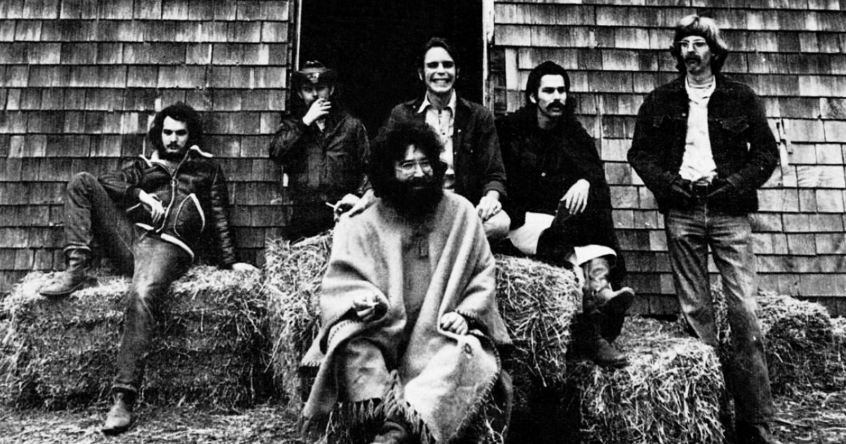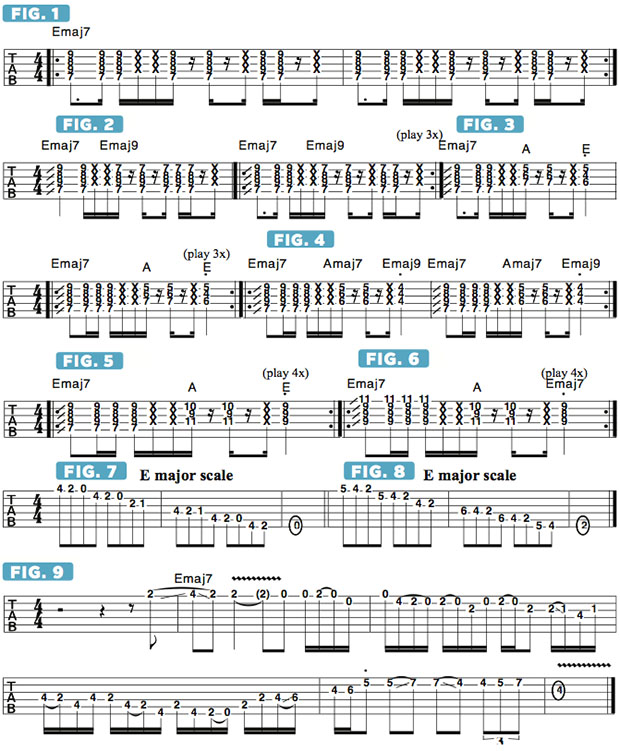Jamming on the Grateful Dead’s “Eyes of the World”

With a fan base that spans three generations, the Grateful Dead have become an essential part of the fabric of American contemporary music.
Their songs are played all around world on a nightly basis in bars, clubs, theaters and stadiums, and a great many guitarists are always glad to accept the challenge of trying to master the band’s more complex tunes. This month, I’d like to turn you onto the Grateful Dead’s 1973 classic, “Eyes of the World.”
The song features a chord progression and groove similar to Marvin Gaye’s 1971 hit, “What’s Going On.” Both songs are in the key of E major and begin with a loose, funky vamp over Emaj7. In “Eyes of the World,” this vamp moves through a few chord changes while residing firmly within the E major tonality.
In FIGURE 1, a seventh-position Emaj7 chord is strummed in a syncopated 16th-note rhythm, with firm downbeat accents on beats one and four and upbeat accents falling within beats two and three. Muted “dead-string” hits, strummed in steady 16th notes, reinforce the groove of the tune. Be sure to keep your pick-hand in constant motion, alternating downstrokes and upstrokes throughout.
There are a few simple permutations that can be added to the underlying rhythm part to make it more interesting. In FIGURE 2, I switch between Emaj7 and Emaj9 in each bar, with the Emaj9 falling on the last 16th note of beat two.
In FIGURE 3, the Emaj9 is replaced by an A major triad, the four chord in the key of E, which then resolves back to E on beat four. We can expand on this idea with the more harmonically textured approach shown in FIGURE 4, as the A chord is replaced with Amaj7 and the resolution is to Emaj9 in fourth position.
Another cool approach is to move the triadic chord forms higher up the fretboard using different inversions, as shown in FIGURES 5 and 6: in FIGURE 5, both the A triad and subsequent E triad are voiced in ninth position, and in FIGURE 6, the first Emaj7 chord is voiced differently than the final one in the progression. As you can see, varying voicings in this way creates subtly different sounds and textures, and exploring these different chord choices is easy and fun to do.
All the latest guitar news, interviews, lessons, reviews, deals and more, direct to your inbox!
When soloing over the track, guitarist Jerry Garcia would take a variety of different approaches in order to attain the musical freedom he always strived for. The simplest approach is to simply stick with the E major scale (E F# G# A B C# D#). Let’s begin with the two lowest positions of this scale, shown in FIGURES 7 and 8: the first is played in first, or “open,” position (so named for the inclusion of open strings), and the second is played one position higher, in second position.
Now let’s combine these two positions to craft an improvised solo over the rhythm part: in FIGURE 9, a four-bar solo is played that begins in open position and then moves up to second and then fourth position as the line progresses. Now that you have the idea, try forging some solo improvisations of your own within these scale positions.
In Deep February 2016 FIGURE 1
In Deep February 2016 FIGURE 2
In Deep February 2016 FIGURE 3
In Deep February 2016 FIGURE 4
In Deep February 2016 FIGURE 5
In Deep February 2016 FIGURE 6
In Deep February 2016 FIGURE 7
In Deep February 2016 FIGURE 8
In Deep February 2016 FIGURE 9

Guitar World Associate Editor Andy Aledort is recognized worldwide for his vast contributions to guitar instruction, via his many best-selling instructional DVDs, transcription books and online lessons. Andy is a regular contributor to Guitar World and Truefire, and has toured with Dickey Betts of the Allman Brothers, as well as participating in several Jimi Hendrix Tribute Tours.

